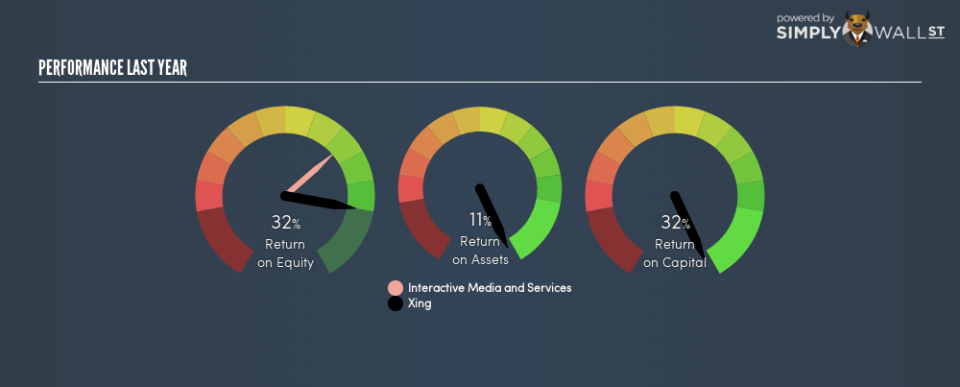Why You Should Like Xing SE’s (ETR:O1BC) ROCE

Today we’ll evaluate Xing SE (ETR:O1BC) to determine whether it could have potential as an investment idea. To be precise, we’ll consider its Return On Capital Employed (ROCE), as that will inform our view of the quality of the business.
First of all, we’ll work out how to calculate ROCE. Then we’ll compare its ROCE to similar companies. Last but not least, we’ll look at what impact its current liabilities have on its ROCE.
Return On Capital Employed (ROCE): What is it?
ROCE measures the amount of pre-tax profits a company can generate from the capital employed in its business. All else being equal, a better business will have a higher ROCE. Ultimately, it is a useful but imperfect metric. Renowned investment researcher Michael Mauboussin has suggested that a high ROCE can indicate that ‘one dollar invested in the company generates value of more than one dollar’.
How Do You Calculate Return On Capital Employed?
The formula for calculating the return on capital employed is:
Return on Capital Employed = Earnings Before Interest and Tax (EBIT) ÷ (Total Assets – Current Liabilities)
Or for Xing:
0.32 = €44m ÷ (€279m – €134m) (Based on the trailing twelve months to September 2018.)
So, Xing has an ROCE of 32%.
View our latest analysis for Xing
Want to participate in a short research study? Help shape the future of investing tools and receive a $60 prize!
Does Xing Have A Good ROCE?
ROCE can be useful when making comparisons, such as between similar companies. Using our data, we find that Xing’s ROCE is meaningfully better than the 26% average in the Interactive Media and Services industry. We consider this a positive sign, because it suggests it uses capital more efficiently than similar companies. Setting aside the comparison to its industry for a moment, Xing’s ROCE in absolute terms currently looks quite high.
It is important to remember that ROCE shows past performance, and is not necessarily predictive. Companies in cyclical industries can be difficult to understand using ROCE, as returns typically look high during boom times, and low during busts. ROCE is only a point-in-time measure. What happens in the future is pretty important for investors, so we have prepared a free report on analyst forecasts for Xing.
Do Xing’s Current Liabilities Skew Its ROCE?
Current liabilities include invoices, such as supplier payments, short-term debt, or a tax bill, that need to be paid within 12 months. The ROCE equation subtracts current liabilities from capital employed, so a company with a lot of current liabilities appears to have less capital employed, and a higher ROCE than otherwise. To counteract this, we check if a company has high current liabilities, relative to its total assets.
Xing has total assets of €279m and current liabilities of €134m. Therefore its current liabilities are equivalent to approximately 48% of its total assets. Xing’s ROCE is boosted somewhat by its middling amount of current liabilities.
The Bottom Line On Xing’s ROCE
Still, it has a high ROCE, and may be an interesting prospect for further research. You might be able to find a better buy than Xing. If you want a selection of possible winners, check out this free list of interesting companies that trade on a P/E below 20 (but have proven they can grow earnings).
For those who like to find winning investments this free list of growing companies with recent insider purchasing, could be just the ticket.
To help readers see past the short term volatility of the financial market, we aim to bring you a long-term focused research analysis purely driven by fundamental data. Note that our analysis does not factor in the latest price-sensitive company announcements.
The author is an independent contributor and at the time of publication had no position in the stocks mentioned. For errors that warrant correction please contact the editor at editorial-team@simplywallst.com.

 Yahoo Finance
Yahoo Finance 
